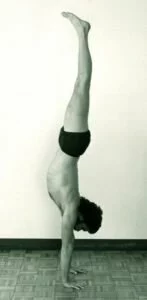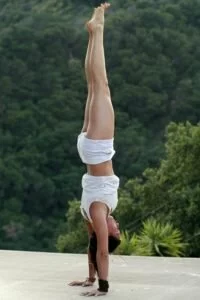 Adho Mukha Vrksasana (ah-doh moo-kah vriks-SHAHS-anna) adho mukha = face, downward (adho = downward; mukha = face), vrksa = tree
Adho Mukha Vrksasana (ah-doh moo-kah vriks-SHAHS-anna) adho mukha = face, downward (adho = downward; mukha = face), vrksa = tree
the handstand, translating to Downward-facing Tree Pose. In capoeira, it is named bananeira.
A handstand is an act of supporting the body in a stable, inverted vertical position by balancing on the hands. In a basic handstand, the body is held straight with arms and legs fully extended, with hands spaced approximately shoulder-width apart. There are many variations of handstands, but in all cases, a handstand performer must possess adequate balance and upper body strength.
Step by Step:-
- Perform Adho Mukha Svanasana (Downward-Facing Dog Pose) with your fingertips an inch or two away from a wall, hands shoulder-width. If your shoulders are tight, turn your index fingers out slightly; otherwise, arrange them parallel to each other. If you’re uneasy about this pose, you’re not alone. To ready yourself for and secure yourself in this inversion, firm your shoulder blades against your back torso and pull them toward your tailbone. Then rotate your upper arms outward, to keep the shoulder blades broad, and hug your outer arms inward. Finally spread your palms and press the bases of the index fingers firmly against the floor.

- Now bend one knee and step the foot in, closer to the wall (we’ll say it’s the left leg), but keep the other (i.e. right) leg active by extending through the heel. Then take a few practice hops before you try to launch yourself upside down. Sweep your right leg through a wide arc toward the wall and kick your left foot off the floor, immediately pushing through the heel to straighten the left knee. As both legs come off the ground, engage your deep core abdominal muscles to help lift your hips over your shoulders. Hop up and down like this several times, each time pushing off the floor a little higher. Exhale deeply each time you hop.
- Hopping up and down like this may be all you can manage for now. Regularly practice strengthening poses, like Adho Mukha Svanasana and Plank Pose. Eventually, you’ll be able to kick all the way into the pose. At first, your heels may crash into the wall, but again with more practice, you’ll be able to swing your heels up lightly to the wall.
- If your armpits and groins are tight, your lower back may be deeply arched. To lengthen this area, draw your front ribs into your torso, reach your tailbone toward your heels, and slide your heels higher up the wall. Squeeze the outer legs together and roll the thighs in. Hang your head from a spot between your shoulder blades and gaze out into the center of the room.
- To start to stay in the pose 10 to 15 seconds, breathing deeply. Gradually work your way up to 1 minute. When you come down, be sure not to sink onto the shoulders. Keep your shoulder blades lifted and broad, and take one foot down at a time, each time with an exhalation. Stand in Uttanasana for 30 seconds to 1 minute. We tend to kick up with the same leg all the time: be sure to alternate your kicking leg, one day right, next day left.
Anatomical Focus:-
- Brain
- Pituitary
- Arms
- Shoulders
- Legs
- Spine
- Lungs
- Wrists
Benefits:-
- Strengthens the shoulders, arms, and wrists
- Stretches the belly
- Improves sense of balance
- Calms the brain and helps relieve stress and mild depression
 Contraindications and Cautions:-
Contraindications and Cautions:-
Back, shoulder, or neck injury
Headache
Heart condition
High blood pressure
Menstruation
If you are experienced with this pose, you can continue to practice it late into pregnancy. Don’t, however, take up the practice of Adho Mukha Vrksasana after you become pregnant.
